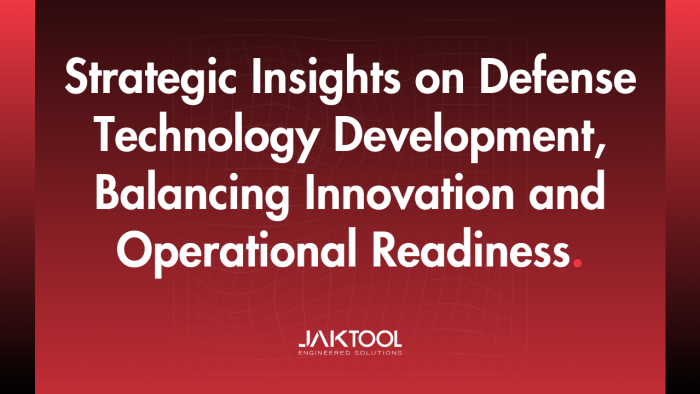Strategic Insights on Defense Technology Development, Balancing Innovation and Operational Readiness

Navigating the complexities of the defense industry demands cutting-edge innovation, a keen sense of practicality, and strategic resource management. Developing military systems like combat vehicles and advanced weaponry requires a fine balance between pushing technological boundaries and ensuring operational readiness. As the landscape of global threats shifts, so must the technologies and strategies that safeguard national security.
This blog explores the critical factors driving defense technology development, emphasizing the importance of aligning innovative solutions with real-world applications to maintain a strong and reliable defense.
The Importance of Innovation in Defense Technology
Innovation in defense technology is paramount. Developing and deploying advanced systems can provide a significant tactical advantage on the battlefield. Whether it’s the introduction of new combat vehicles, weapons systems, or logistical support technologies, innovation drives the evolution of military capabilities. However, pursuing cutting-edge technology must be carefully managed to avoid pitfalls that can arise from pushing the boundaries too far too fast.
One of the challenges in defense innovation is ensuring that new technologies are both effective and reliable. This involves rigorous testing and validation processes that simulate real-world conditions. Defense projects often involve prototyping and iterative testing to identify and resolve issues before a system is deployed in the field. This process can be time-consuming and costly, but it is essential for ensuring that the technology will perform as expected under extreme combat conditions.
Balancing Cost and Capability
While innovation is crucial, it must be balanced with budgetary constraints. Defense budgets are finite, and every new technology must justify its cost in terms of operational capability. The key to successful defense technology development lies in strategic budgeting that prioritizes essential capabilities while maintaining flexibility for unforeseen challenges.
A common issue in defense projects is the escalation of costs due to unforeseen technical challenges or changes in project scope. To mitigate this, it is vital to establish precise requirements and maintain disciplined project management practices. This includes setting realistic cost estimates, conducting regular reviews, and being prepared to make tough decisions about whether to continue, modify, or cancel a project if it exceeds its budget or fails to meet performance expectations.
The Role of Prototyping and Testing
Prototyping is a critical phase in the development of defense technologies. It allows engineers and developers to test new concepts in a controlled environment, identify potential flaws, and make necessary adjustments before full-scale production begins. Prototyping is essential in the defense industry because it provides a way to assess the practicality of new technologies under conditions that closely resemble actual combat scenarios.
In addition to prototyping, rigorous testing is essential. This includes technical testing, which focuses on the system’s performance, and operational testing, which evaluates how well the system integrates with existing military infrastructure and procedures. Testing helps ensure that the final product meets technical specifications, is user-friendly, and is effective in real-world applications.
Navigating the Transition from Development to Deployment
Once a defense technology has been developed and tested, the next challenge is transitioning it from development to deployment. This process involves scaling up production, training military personnel to use the new technology, and integrating it with existing systems. Effective communication and coordination between developers, manufacturers, and military stakeholders are crucial during this phase.
The deployment phase also involves logistics and supply chain management, ensuring that the necessary parts and support systems are in place to maintain the technology throughout its operational life. This requires careful planning and adapting to changing circumstances, such as shifts in geopolitical conditions or budgetary constraints.
The Importance of Knowledge Transfer and Continuous Improvement
One of the most valuable aspects of defense technology development is the knowledge gained throughout the process. Documenting and transferring this knowledge to future projects is essential, ensuring that lessons learned are not lost and that new technologies can build on previous successes while avoiding past mistakes. Continuous improvement is a cornerstone of successful defense technology development, allowing for refining processes and technologies over time.
As a preferred vendor of the Department of Defense, we have frequently worked on innovative projects, and over the years, we have amassed significant expertise. This deep understanding of DoD requirements and projects has strengthened our relationship with the organization and enabled us to offer additional value through our extensive knowledge.
Training the next generation of engineers and developers is crucial for maintaining a robust defense capability. Mentorship and knowledge sharing within the defense community help to ensure that new talent is equipped with the insights and experience necessary to tackle the challenges of future defense projects.
The Path Forward in Defense Technology Development
Defense technology development is a complex and challenging endeavor that requires a strategic approach to innovation, cost management, and operational readiness, a process our team at JAKTOOL excels at. By balancing these factors, defense organizations can ensure that they are developing cutting-edge technologies and deploying reliable systems that enhance national security.
As the global landscape evolves, adapting and improving will remain vital to maintaining a technological edge in defense.
WHAT IS THE VISION VAULT?
The JAKTOOL Vision Vault is a space for us to expand on the passions that drive innovation and growth at our company. On this blog, we’ll take deeper dives into industry news and our expertise and highlight the leaders we have under our own roof through featured blogs. Follow along for updates throughout the month and recaps on new episodes of JAKTALK, our biweekly podcast hosted by our founder, COO, chairman, and visionary, Jeff Kinsberg.
This article is based on conversations had in JAKTALK episode #11. You can watch the full episode on YouTube.
